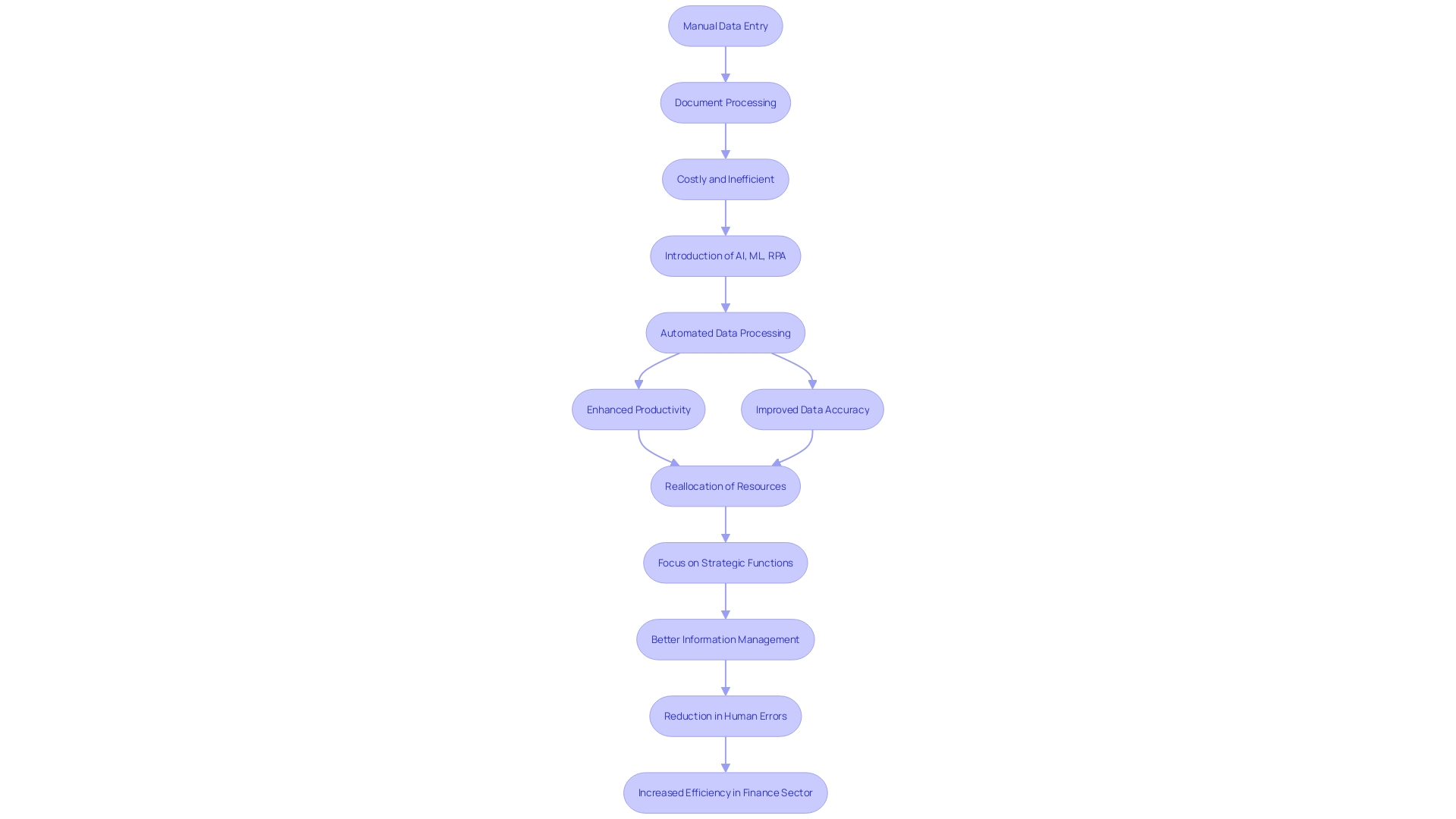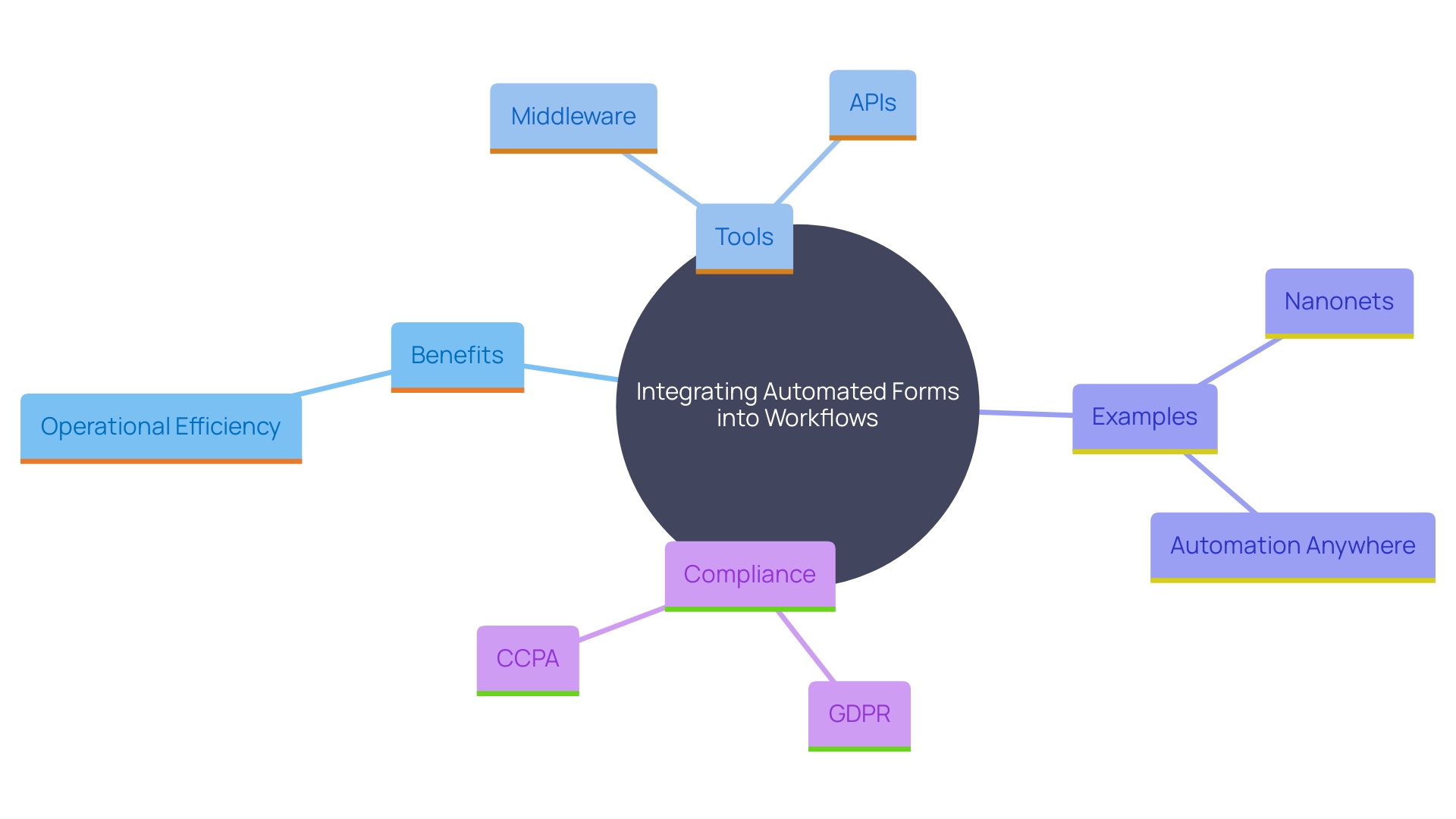Introduction
In an increasingly data-driven world, the efficiency of operations hinges on the ability to manage and process information swiftly and accurately. Automated form processing stands at the forefront of this transformation, offering organizations a way to shift from manual, error-prone data entry to a streamlined, reliable system. By reallocating resources from routine tasks to strategic functions, businesses can boost productivity and foster innovation.
With industries like finance demonstrating the potential to automate up to 80% of operations, the impact is profound. The integration of AI into form automation further amplifies these benefits, ensuring compliance, reducing turnaround times, and enhancing decision-making. Real-world applications, from healthcare to financial services, showcase the tangible improvements in operational efficiency and accuracy, underscoring the importance of embracing these advanced technologies.
As businesses integrate automated forms into existing workflows, the promise of a more unified, productive, and compliant operational framework becomes a reality, paving the way for sustained growth and success.
Benefits of Automated Form Processing
Automated form processing alters information collection and management by significantly reducing the time and effort linked with manual entry. This reallocation of resources from repetitive tasks to more strategic functions not only boosts productivity but also empowers teams to engage in higher-value activities that foster innovation and growth. As stated by Rob Lawrence, Chief Operating Officer of Formstack, the incorporation of automated tools can enhance information management, enabling organizations to gather and use information more efficiently. Furthermore, the use of technology improves data precision and dependability by minimizing the chance of human mistakes, an essential element in preserving the integrity of information. This change is especially clear in sectors such as finance, where, as highlighted by Accenture, up to 80% of processes have the capacity for mechanization, allowing staff to concentrate on strategic initiatives. By embracing these advanced technologies, organizations can achieve a more efficient, accurate, and innovative operational framework.

Key Advantages of Form Automation
Form mechanization provides numerous advantages, including increased efficiency and shorter turnaround times. Automated systems manage documents instantly, facilitating quicker decision-making and faster service delivery. Furthermore, mechanization strengthens adherence by making certain documents are precisely filled out and conform to regulatory standards, thus reducing the chance of fines or legal complications.
The incorporation of AI into form processing further enhances these advantages. In contrast to conventional mechanization, which functions on a straightforward cause-and-effect system, AI can understand intricate inputs. For example, rather than just responding to a ‘yes’ or ‘no,’ AI can analyze entire paragraphs to determine intent, making it highly effective in processing unstructured or random inputs.
The movement towards AI and mechanization is not merely a trend but a strategic priority for many companies. According to Forbes, 83% of companies consider AI crucial for their operations. This transition is supported by advancements in no-code AI platforms, which allow businesses to become data-driven without the need for extensive data science teams.
Practical uses illustrate the concrete advantages of mechanization. For instance, the use of PDFfiller in sectors requiring extensive documentation, such as medical, insurance, and banking, showcases how technology tools can simplify daily tasks and improve operational efficiency.
As technology keeps advancing, the importance of mechanization in business operations will only grow, providing a strong method to improve efficiency and adherence.
Integrating Automated Forms with Existing Workflows
Integrating automated forms into existing workflows seamlessly is essential to harness their full potential. Employing APIs and middleware options can link automated tools with existing systems, ensuring seamless data transfer between applications. This approach promotes a unified process management system, breaking down silos and significantly boosting overall operational efficiency. For instance, Nanonets provides strong options that automate the handling of invoices, bills, and receipts, saving countless hours for the workforce. By selecting an appropriate AI model and setting up an auto-import option, organizations can streamline document processing, whether from email inboxes, cloud storage, or physical scanners.
A practical illustration of effective integration is Automation Anywhere’s success in improving business operations through AI-driven systems. Their GenAI-powered solutions have contributed to 30% of bookings, reflecting an increasing customer preference for merging AI and automated technologies to address complex challenges. This success underscores the importance of using advanced tools to achieve seamless integration and improved productivity.
Moreover, incorporating automation tools can assist organizations in remaining compliant with growing privacy regulations, such as GDPR and CCPA. TikTok’s €345 million fine and Sephora’s $1.2 million settlement highlight the costly consequences of non-compliance. Automated systems can efficiently track, manage, and audit consumer information requests, ensuring adherence to legal requirements and safeguarding against penalties.

Real-World Examples of Automated Form Solutions
Enterprises in different industries have utilized the capabilities of automated document solutions to transform their operations. In healthcare, providers are utilizing automated patient intake documents to optimize information gathering, improving both efficiency and patient experience. This approach minimizes administrative burdens and speeds up the process, ensuring that healthcare professionals can focus more on patient care. In the financial sector, institutions have adopted automated loan application documents, which not only expedite the approval process but also maintain high data accuracy. This reduces the risk of errors and accelerates loan processing times, benefiting both the institution and the applicants.
Moreover, digital formats have become the new standard, especially post-pandemic. Unlike conventional paper documents, digital alternatives are created with human-centered principles to guarantee a smooth user experience. This shift is evident in government operations, where most forms have moved online, making processes more efficient and user-friendly.
‘The effect of these automated solutions is further emphasized by the fact that over 20,000 organizations, including industry leaders like Advent Health and Netflix, depend on platforms like Formstack for information collection and management.’. These platforms offer advanced workflow automation and a suite of capabilities that empower organizations to optimize their processes. As Rob Lawrence, Chief Operating Officer of Formstack, stated, ‘Formstack has a history of helping customers capture data and put it to work.’ This sentiment highlights the transformative potential of automated form solutions in driving operational excellence and innovation across industries.
Conclusion
Automated form processing is transforming operational efficiency by drastically reducing the time and effort required for manual data entry. This shift allows organizations to redirect resources toward strategic initiatives, enhancing productivity and fostering innovation. In industries like finance, the capacity to automate a large portion of operations enables employees to focus on higher-value tasks.
The advantages of form automation extend beyond mere efficiency. Organizations benefit from faster turnaround times, improved compliance, and enhanced data accuracy, which are crucial for navigating complex regulatory landscapes. The integration of AI further elevates these benefits by enabling the effective interpretation of intricate data inputs.
This strategic shift underscores the growing importance of automation and AI in modern business operations.
To fully leverage automated forms, seamless integration into existing workflows is essential. Utilizing APIs and middleware solutions fosters a unified system that streamlines data management and boosts overall efficiency. Real-world examples highlight significant operational improvements and compliance with evolving data privacy regulations across various sectors.
The impact of automated form solutions is evident, enhancing both operational efficiency and user experience. As organizations increasingly adopt these advanced technologies, they lay the groundwork for a more innovative and compliant operational framework, positioning themselves for sustained success in a competitive landscape.

